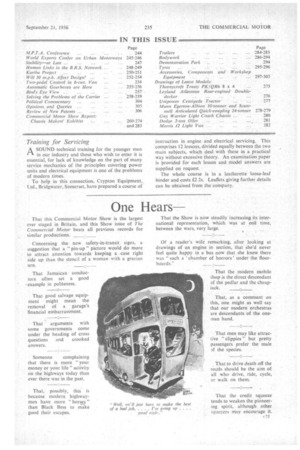Passing Comments
Page 86

Page 87

If you've noticed an error in this article please click here to report it so we can fix it.
Electric Power from Sunshine
THE charging of the batteries of electric vehicles
by sunshine may seem futuristic, but at least it would become possible if solar electric stations became popular. One of these, which is to be built in Armenia, will consist of 1,293 large mirrors which will turn to face the sun and reflect its rays on to a large boiler; the movement being automatically controlled by photo-electric cells. The mirrors are carried on what might be called automatic trains, which run on 23 circular tracks.
The disadvantage is the area required, which in this instance has a diameter of about mile. It is to be bordered with trees in an endeavour to keep the mirrors free from dust.
Steam from the boiler will drive a 1.200-kW. dynamo through the medium 'of a turbine.
"Throw-away" Engines for U.S. Army
THE American Army Ordnance Corps are looking for a " throw-away " engine to power their lightweight vehicles, hoping to find a unit cheaper to abandon than to repair when it breaks down.
The need for such an engine, together with faster and lighter vehicles, has been brought about by a change in modern warfare. The requirement today is to convey troops rapidly to where they are needed. To attain this the Army authorities want many more small wheeled and tracked vehicles.
To meet this radical shift from large, heavy, highpowered vehicles, the American motor industry is to be asked to develop small, light engines of medium power. An ideal unit would be a "super power plant giving 1 h.p. per cu. in. of displacement, 1 h.p. per c20 lb. and costing less than a dollar per h.p.," said recently a spokesman of the Corps.
At present the U.S. Army is getting 1 h.p. for about five or six dollars (35s.-42s.)—an output of about 0.5 h.p. per Cu. in. at a weight of some 4+ lb. per h.p. The American authorities now realize that engines outliving the vehicles they power are wasteful and they think that the answer to their problem lies in an engine that could be factory tested, sealed, issued and written off.
A promising engine for the future is the small gas turbine, operating on regenerative cycles. A prototype of such an engine is being tested and it is hoped that it will be ready for commercial production in three years. Although this unit is not as good on fuel consumption as a piston engine, its small size is highly desirable. The small gas turbine costs about £14. per h.p., but it is thought that, with mass production, this could be reduced below the 35s. per htp. which is the cost of the piston engine.
With slight modification the new " throw-away " engines could be used in cars and small lorries.
Forty-two Years of Coachbuilding
A MOST attractive production is the 1957 Duple
Annual, produced by Duple Motor Bodies, Ltd. It contains excellent illustrations, many in colour, of this well-known bodybuilder's products in the way of coaches and buses. A section is devoted to the vehicles which achieved such high successes this year at the Brighton Coach Rally.
Not everyone knows that Duple were first established in Fareham, Hants. in 1914, and became a limited company in 1919. when they moved to London, and in 1926 to 12 acres at Hendon.
Training for Servicing
A SOUND technical training for the younger men 4-1 in our industry and those who wish to enter it is essential, for lack of knowledge on the part of many service mechanics of the principles covering power units and electrical equipment is one of the problems of modern times.
To help in this connection, Crypton Equipment, Ltd., Bridgwater, Somerset, have prepared a course of instruction in engine and electrical servicing. This comprises 12 lessons, divided equally between the two main subjects, which deal with these in a practical way without excessive theory. An examination paper is Provided for each lesson and model answers are supplied on request.
The whole course is in a leatherette loose-leaf binder and costs £2 2s. Leaflets giving further details can be obtained from the company.




































































































































































































































































































































